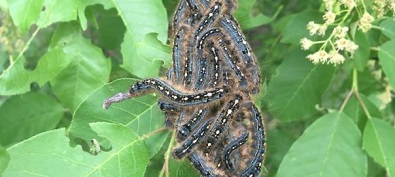Photo courtesy of critterfiles.com
Another season of dealing with tent caterpillars and cankerworms is here for Saskatchewan residents.
Every spring, the caterpillars find their way into the aspen forests in the province. The tent caterpillar will feed mostly on aspen or poplar trees, but if there is not an available food source, it may turn to other deciduous trees like maple or elm.
Dr. Rory Macintosh is with the Ministry of Environment. He says the tent caterpillars will run in ten to twelve-year outbreak cycles, with some outbreaks lasting three to five years. He says in the northern forests, the peak was in 2015, but areas further south in the prairies are seeing peak outbreaks right now.
“The insect itself is geared very close with bud flush of the trees, so when the trees are starting to leaf out is typically when you will see the caterpillars hatch out and start eating on the fresh foliage,” he added.
He says many areas have been seeing more tent caterpillars this spring, and there is an abundant food source in the boreal forest in central and northern Saskatchewan. At the same time, he says there isn’t much the province has been doing for control in the crown land forest areas.
“There are bacterial sprays that can be used, but the ministry doesn’t typically spray for tent caterpillars because they seldom end up killing the tree,” he says. “It will defoliate the tree and the area will look like a winterscape in June and July, but the leaves will grow back.”
He says that at this point in the outbreak and in this year’s cycle, it is beyond the point where control with insecticides would help.
He says if the infestation is to the point where the caterpillars are on a person’s house or deck, the best solution is to use a high-powered water spray to knock them off.
“The best thing to do is to not allow them to make cocoons inside soffits, air vents or air conditioners because they are very difficult to get off the house once they have spun their cocoons,” he added.
He says there can be a big nuisance factor with the insects covering siding and decks and also eating foliage on aspen trees. He says the caterpillar cycle is nearing its end for the year, and the leaves will grow back before the end of July.
